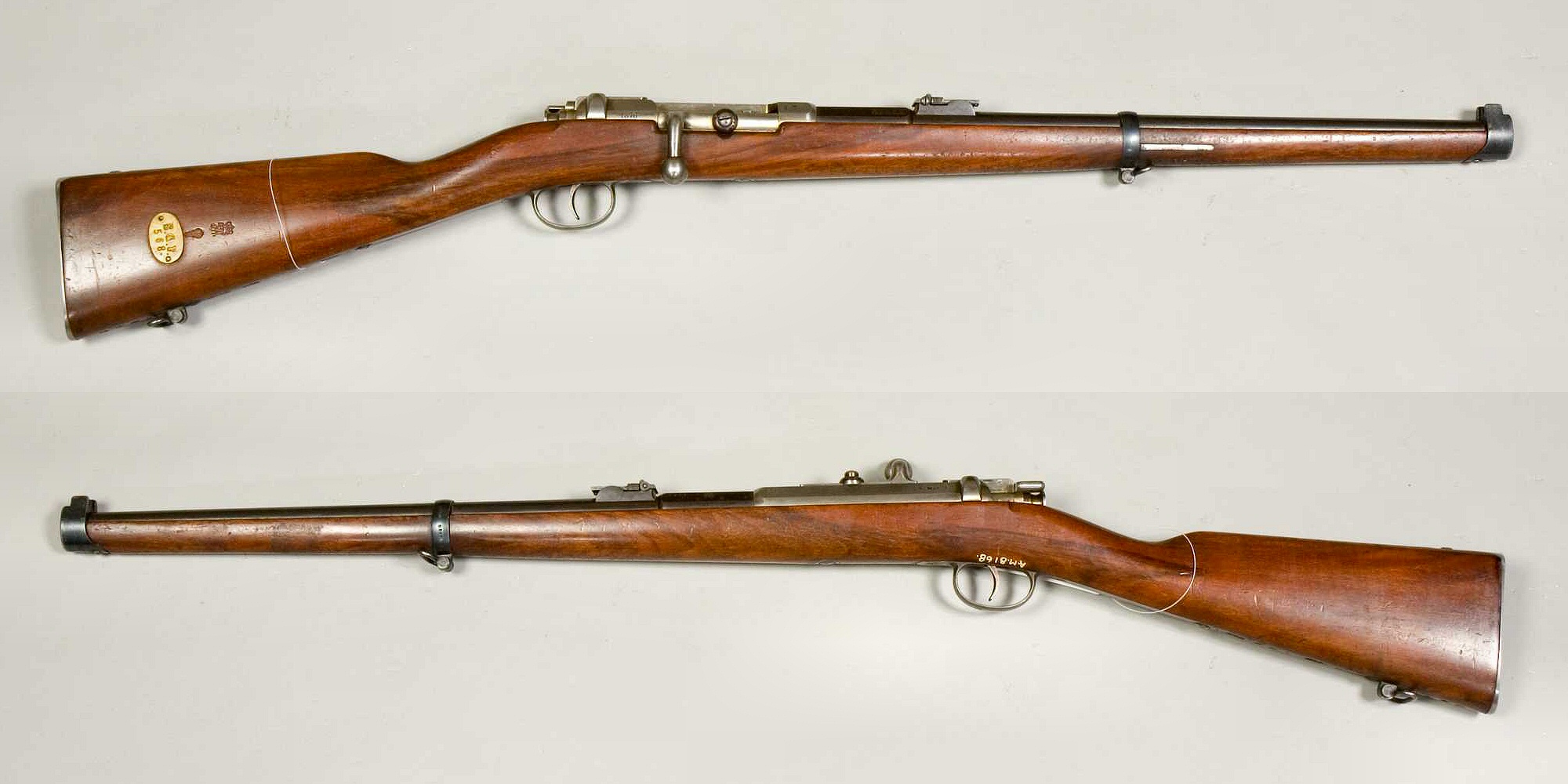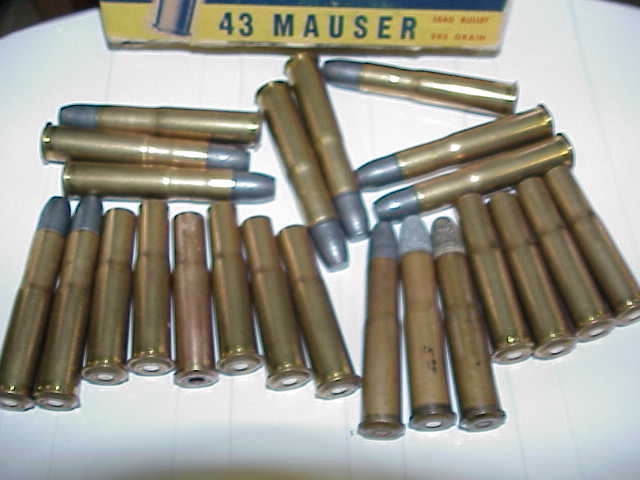
Some Gun Humor




Over the years, I have seen a few of these for sale at various Gun Shows. (But none at any Gun Shops for some reason. Go figure!)
Of course being the idiot that I am. I always passed up the chance to buy one. Now their costs are really out of my price league. (It was over a Grand!)
The last one I saw. Looked liked it had been dragged across Africa a couple of time by a pack of vicious baboons. Oh well!

Now I have not yet been lucky enough to shoot one of these old timers.
But since it shoots a black power backed bullet. The recoil hopefully would be more of a shove. Instead of the World Heavyweight Champion giving out his Sunday best.

All I know is that I would NOT want to get hit by one of these heavy, slow rounds!
No Thank you sir!

But hopefully one day! I shall run across one for sale & have the funds to pay for it also.
Here is some more information about this Early Bolt Action. Thanks for the time! Grumpy
Mauser Model 1871
| Mauser Model 1871 / Gewehr 71 | |
|---|---|

Mauser Model 1871
|
|
| Type | Service rifle |
| Place of origin | German Empire |
| Service history | |
| In service | 1872–1918 (Germany) |
| Used by | Germany See Operators |
| Wars | Satsuma Rebellion, First Boer War, Serbo-Bulgarian War First Sino-Japanese War, Second Boer War, Boxer Rebellion, Balkan Wars, Serbo-Bulgarian War, Easter Rising, World War I (limited) |
| Production history | |
| Designer | Mauser |
| Designed | 1866–1872 |
| Manufacturer | Mauser |
| Variants | Jägerbüchse Carbine M1878/80(Serbia) G.A.G. M1879(Border Guards) M71/84 M1887(Turkey) M80/07C(Serbia) |
| Specifications | |
| Weight | 4.5 kg (9.92 lbs) |
| Length | 1350 mm (53.15 in) |
| Barrel length | 855 mm (33.66 in) |
|
|
|
| Cartridge | 11.15×60mmR 10.15×63mmR 11.15×37mmR 9.5×60mmR 11×59mmR Gras 7×57mm 7.65×53mm 6.5×53.5mmR |
| Caliber | .43 |
| Action | Bolt action |
| Muzzle velocity | 1,430 ft/s (440 m/s) (11×60mmR) |
| Feed system | Single-shot M71/84: 8-round tubular magazine M80/07: 5-round stripper clip, internal magazine |
| Sights | Iron sights |

German Empire, 1871–1918; the rifle was adopted by the German Empire excluding Bavaria. This included areas that were annexed by France, Poland and Russia during the 20th Century.
The Mauser Model 1871 adopted as the Gewehr 71 or Infanterie-Gewehr 71, or “Infantry Rifle 71 (“I.G.Mod.71” was stamped on the rifles themselves) was the first rifle model in a distinguished linedesigned and manufactured by Paul Mauser and Wilhelm Mauser of the Mauser company and later mass-produced at Spandau arsenal.[1]
History and design
Paul Mauser developed his bolt-action rifle from 1866 to 1871.[2]During 1870–71 trials with many different rifles took place, with the “M1869 Bavarian Werder” being the Mausers’ chief competitor. The Mauser was provisionally adopted on 2 December 1871, pending the development of an appropriate safety. With support from the government’s Spandau arsenal, the improvements to the safety mechanism were completed and the rifle was formally accepted on 14 February 1872 as Infantry Rifle Model 1871 by the German Empire excluding Bavaria. The action was not based on its predecessor, the Dreyse needle gun which had seen service during the Franco-Prussian War of 1870–71, and which was found to have a number of weaknesses.[1]
The now well known Mauser “wing” type safety lever was developed for the Gewehr 71. The Gewehr 71 is a conventional looking bolt action chambered in 11mm using black powder cartridges. The action included only a bolt guide rib as its single locking lug, locking forward of the receiving bridge. The original design was a single-shot. The design was updated in 1884 with an 8-round tubular magazinedesigned by Alfred von Kropatschek, making this Germany’s first repeating rifle. This version was designated the Gewehr 1871/84.[3]A version of this repeater was adopted by the Ottoman Empire. Designated the M1887, it differentiated from the M71/84 in that it had a side mounted cleaning rod, a second locking lug on the rear of the bolt, and it was in caliber 9.5×60mmR, which Paul Mauser touted as the most efficient (black powder) cartridge. In the early 20th century a few were converted to 7.65×53mm smokeless by the arsenal in Ankara.
A shorter version of the Model 1871, the M1879 Grenzaufsehergewehr, was issued to the border guards in 1880. It shot a unique 11.15×37.5mmR cartridge, a trimmed down version of the full-power military cartridge.[4]
Serbia adopted a more up-to-date version of the rifle in 1881, the M1878/80, still single-shot, but chambered in its own 10.15×63R caliber. It had unique additions in that it had a bolt guide (much like the M1870 Italian Vetterli) and the “progressive rifling” (rifling which increases in twist rate as the bullet travels up the bore, to more gradually impart spin) developed by the Serbian Major Kosta “Koka” Milovanović (Коста “Кока” Миловановић), and it is commonly known as “Mauser-Koka“, “Mauser-Milovanović”, or “Kokinka” (“Кокинка”). The muzzle velocity of the Mauser-Koka was 1,680 feet per second (510 m/s). It saw first combat in the Serbo-Bulgarian War. Approximately 110,000 Mauser-Koka rifles entered the Serbian arsenal. Starting 1907, about half of these were converted in Kragujevac to shoot the 7×57mm from a 5-shot box magazine; the new barrels were purchased from Steyr. Both the old and new guns (designated M80/07) saw action in the Balkan Wars and World War I.[5] The converted M80/07 are often referred to as “Đurić Mausers” (Ђурић-Маузер).[6]
The M71 was used by the Korean Empire Army (especially Guard units—this rifle replaced the Russian Berdan rifle). The number of rifles used is uncertain but the Korean Empire manufactured ammunition for them, which means that the Korean Empire used a respectable number of them.
In 1894, Uruguay had their stockpile of M71 rifles converted to 6.5×53.5mm SR by Société Française d’Armes Portatives Saint Denis in France. They were given new stocks, barrels, sights, bands, and side mounted cleaning rods. These were unsatisfactory due to weak springs, and many were thrown away.[citation needed]
Irish Republicans imported some 900 single-shot 1871 Mausers in the Howth gun-running for the nationalist militia called the Irish Volunteers in 1914. They were used in action by the Volunteers in the Easter Rising of 1916, an unsuccessful insurrection aimed at ending British rule in Ireland. The 1871 Mauser became known in Ireland as the “Howth Mauser”.[7]
Comparison with contemporary rifles
| Calibre | System | Country | Velocity | Height of trajectory | Ammunition | Source | ||||||||
|---|---|---|---|---|---|---|---|---|---|---|---|---|---|---|
| Muzzle | 500 yd (460 m) | 1,000 yd (910 m) | 1,500 yd (1,400 m) | 2,000 yd (1,800 m) | 500 yd (460 m) | 1,000 yd (910 m) | 1,500 yd (1,400 m) | 2,000 yd (1,800 m) | Propellant | Bullet | ||||
| .433 in (11.0 mm) | Werndl | Austria-Hungary | 1,439 ft/s (439 m/s) | 854 ft/s (260 m/s) | 620 ft/s (190 m/s) | 449 ft/s (137 m/s) | 328 ft/s (100 m/s) | 8.252 ft (2.515 m) | 49.41 ft (15.06 m) | 162.6 ft (49.6 m) | 426.0 ft (129.8 m) | 77 gr (5.0 g) | 370 gr (24 g) | [8] |
| .45 in (11.43 mm) | Martini–Henry | United Kingdom | 1,315 ft/s (401 m/s) | 869 ft/s (265 m/s) | 664 ft/s (202 m/s) | 508 ft/s (155 m/s) | 389 ft/s (119 m/s) | 9.594 ft (2.924 m) | 47.90 ft (14.60 m) | 147.1 ft (44.8 m) | 357.85 ft (109.07 m) | 85 gr (5.5 g) | 480 gr (31 g) | [8] |
| .433 in (11.0 mm) | Gras | France | 1,489 ft/s (454 m/s) | 878 ft/s (268 m/s) | 643 ft/s (196 m/s) | 471 ft/s (144 m/s) | 348 ft/s (106 m/s) | 7.769 ft (2.368 m) | 46.6 ft (14.2 m) | 151.8 ft (46.3 m) | 389.9 ft (118.8 m) | 80 gr (5.2 g) | 386 gr (25.0 g) | [8] |
| .433 in (11.0 mm) | Mauser | Germany | 1,430 ft/s (440 m/s) | 859 ft/s (262 m/s) | 629 ft/s (192 m/s) | 459 ft/s (140 m/s) | 388 ft/s (118 m/s) | 8.249 ft (2.514 m) | 48.68 ft (14.84 m) | 159.2 ft (48.5 m) | 411.1 ft (125.3 m) | 75 gr (4.9 g) | 380 gr (25 g) | [8] |
| .408 in (10.4 mm) | Vetterli | Italy | 1,430 ft/s (440 m/s) | 835 ft/s (255 m/s) | 595 ft/s (181 m/s) | 422 ft/s (129 m/s) | 304 ft/s (93 m/s) | 8.527 ft (2.599 m) | 52.17 ft (15.90 m) | 176.3 ft (53.7 m) | 469.9 ft (143.2 m) | 62 gr (4.0 g) | 310 gr (20 g) | [8] |
| .397 in (10.08 mm) | Jarmann | Norway and Sweden | 1,536 ft/s (468 m/s) | 908 ft/s (277 m/s) | 675 ft/s (206 m/s) | 504 ft/s (154 m/s) | 377 ft/s (115 m/s) | 7.235 ft (2.205 m) | 42.97 ft (13.10 m) | 137.6 ft (41.9 m) | 348.5 ft (106.2 m) | 77 gr (5.0 g) | 337 gr (21.8 g) | [8] |
| .42 in (10.67 mm) | Berdan | Russia | 1,444 ft/s (440 m/s) | 873 ft/s (266 m/s) | 645 ft/s (197 m/s) | 476 ft/s (145 m/s) | 353 ft/s (108 m/s) | 7.995 ft (2.437 m) | 47.01 ft (14.33 m) | 151.7 ft (46.2 m) | 388.7 ft (118.5 m) | 77 gr (5.0 g) | 370 gr (24 g) | [8] |
| .45 in (11.43 mm) | Springfield | United States | 1,301 ft/s (397 m/s) | 875 ft/s (267 m/s) | 676 ft/s (206 m/s) | 523 ft/s (159 m/s) | 404 ft/s (123 m/s) | 8.574 ft (2.613 m) | 46.88 ft (14.29 m) | 142.3 ft (43.4 m) | 343.0 ft (104.5 m) | 70 gr (4.5 g) | 500 gr (32 g) | [8] |
| .40 in (10.16 mm) | Enfield-Martini | United Kingdom | 1,570 ft/s (480 m/s) | 947 ft/s (289 m/s) | 719 ft/s (219 m/s) | 553 ft/s (169 m/s) | 424 ft/s (129 m/s) | 6.704 ft (2.043 m) | 39.00 ft (11.89 m) | 122.0 ft (37.2 m) | 298.47 ft (90.97 m) | 85 gr (5.5 g) | 384 gr (24.9 g) | [8] |
Operators[edit]
 Serbia
Serbia Japan
Japan Thailand
Thailand China
China Ecuador
Ecuador Uruguay
Uruguay South Africa
South Africa Korea
Korea Venezuela
Venezuela- Irish Volunteers
 Honduras[9]
Honduras[9]
In fiction and popular culture[edit]
11-mm Mauser is the service rifle of the Martian Army in The Sirens of Titan by Kurt Vonnegut.[10] Though, the book states these were bought as surplus from the Spanish–American War, which would in fact make them Model 1893 7×57mm Mauser.
In the film The Last Samurai, the Japanese Imperial Army carries German bolt-action Mauser M1871/84 rifles, in spite of the fact they were supposedly being armed by the United States. The 1884 models were altered in appearance by film makers to resemble the more period accurate 1871 models.
Gallery[edit]
-
Askari troops in German East Africa armed with Model 1871s
The US Army's Oldest Active Duty Unit
Bet you did not know about these dandies? HUH?
Grumpy

First Troop Philadelphia City Cavalry

Captain Joseph Lapsley Wilson of the First City Troop circa 1894
The First Troop Philadelphia City Cavalry, also known as the First City Troop, is a unit of the Pennsylvania Army National Guard. It is the oldest military unit in the United States still in active service and is among the most decorated units in the U.S. Army. Accordingly, the Troop operates under a number of principles of self-governance unique in the U.S. military, including the election of unit members and officers, voluntarily forgoing pay for their military service to the country, continuing to practice horse cavalry skills and tactics, and recruiting a high percentage of its members from veterans of prior active duty service across all branches (many of whom resign past officer commissions to join), as well as older civilian mid-career professionals.[1]
It is the only U.S. military unit that owns its own armory building, built with private funds in Philadelphia’s Rittenhouse Squareneighborhood.
As of 2014, the troop had 35 active members, down from 86 in 2000.[1]
Contents
[hide]
History[edit]
The First Troop Philadelphia City Cavalry, or “First City Troop”, was organized in 1774 as the Light Horse of the City of Philadelphia, often referred to as the Philadelphia Light Horse, one of the first patriotic military organizations established in the American Revolution.
Abraham Markoe was the founder and the first Captain[2] of the Philadelphia Light Horse, known today as the First Troop Philadelphia City Cavalry.[3]
Early members came from a number of local social organizations, including the Schuylkill Fishing Company, the Schuylkill Company of Fort St. Davids, the St. Andrew’s Society of Philadelphia, the Society of the Friendly Sons of St. Patrick, the Society of the Sons of St. George, and especially the Gloucester Fox Hunting Club. Captain Samuel Morris was Gloucester’s first president and Captain Robert Wharton its last.
During the Revolution, the troop fought in the battles of Trenton, Princeton, Brandywine, and Germantown. It often served as George Washington‘s personal bodyguard. The unit also saved James Wilson at the “Battle of Fort Wilson” riot.
During the American Civil War, the First City Troop was called into active duty several times, beginning with the 1861 Campaign that led to the First Battle of Bull Run. During the Gettysburg Campaign, the company, under the command of future U.S. Speaker of the House Samuel J. Randall, performed scouting duties leading into the Battle of Gettysburg, Pennsylvania, in late June before being redeployed to York County following a brief skirmish on June 26, 1863. The company later screened Columbia-Wrightsville Bridge against the Confederateforces of John Brown Gordon.
John J. Pershing said that “no National Guard organization in the country did more, relatively, in the First World War than” the First City Troop.[4]
Today, the First City Troop deploys overseas with the Pennsylvania National Guard in support of Army operations. Since 9/11, the unit has deployed to Bosnia, Iraq, Egypt, and Kuwait, with elements of the unit additionally deploying to Afghanistan, the Persian Gulf, Europe, and Latin America. Membership is by election. Soldiers on the active roll continue to donate their drill pay back to the unit, in order to maintain a tradition of voluntary service.
The troop draws its membership from Troop A, 1st Squadron, 104th Cavalry Regiment, 28th Infantry Division (United States), Pennsylvania Army National Guard.
References[edit]
- ^ Jump up to:a b Phillips, Michael (October 15, 2014). “Philadelphia Is Looking for a Few Good Gentlemen”. New York. Wall Street Journal. Retrieved October 21, 2014.
- Jump up^ “History:Philadelphia (1774–1775)”. FTPCC web site. First Troop, Philadelphia City Cavalry. Archived from the original on 18 August 2010. Retrieved 2010-09-01.
Abraham Markoe, a Danish subject, was chosen to be the first Captain because of his energy in organizing the Troop and his previous Danish military experience. Though prevented from open participation in the War as a result of the Neutrality Edict issued by then King Christian VII of Denmark, Captain Markoe took an active part in the defeat of the enemy by all other available means.
- Jump up^ Johnson, Robert (2006). Saint Croix 1770–1776: The First Salute to the Stars and Stripes. AuthorHouse. p. 20. ISBN 978-1-4259-7008-6.
This same Abraham Markoe, in 1775, organized the Light Horse Troop of Philadelphia, and presented the troop with what is considered the first flag with thirteen stripes representing the thirteen colonies.
- Jump up^ Hudson, Richard L. 1980. “At Ease, Troopers: Fall Out for Caviar and Pickled Herring. That’s the Order Often Heard at Elite Philadelphia Club, A Unit of the National Guard.” Wall Street Journal. February 29, 1980. Page A1
Army Flashback


Because if you are in the area.


There is a pretty good gunshop there called Gunrunners. I have been going there for the past couple of years. Where I have picked up some pretty good deals in that time.
So again if you are in the area. It might behoove one to stop by and say hello!
Grumpy
https://www.gunrunnerstactical.com/

Phone: (626) 358-7711 Fax: (626) 358-2831
Email: 
2160 E. Huntington Dr, Suite D, Duarte CA 91010 USA
use Mt Olive exit from the 210
Parking in front, also behind the restaurant next door.
Healthy Looking Ladies NSFW
Enjoy! Grumpy





Since it is a clean, simple and not over the top message.
That & it addresses one of the few new markets left open to the Gun Industry, The Ladies of America. As it seems to play on their fears of crime.
What are your thoughts on this?
A Really Hard to make a buck!
Or how to stick a blade into some poor sap with that knife stuck on your gun.
Preview YouTube video 어드미럴 (Admiral, 2008)
Preview YouTube video Bayonet Fighting
Preview YouTube video Admiral (2008) – First scene – EN sub, CZ dub
Preview YouTube video How to KILL with a Bayonet!
Preview YouTube video Boot Camp: Bayonet Training
Preview YouTube video US Marines Brutal Bayonet Charge During Assault – M4 Carbine Shooting

















